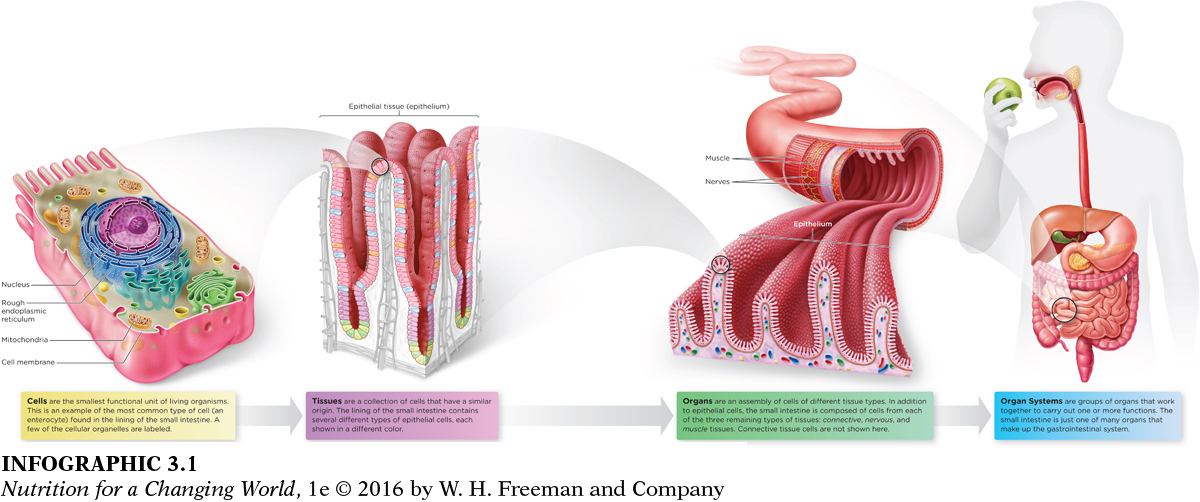Chapter Introduction
3
DIGESTION

49
LEARNING OBJECTIVES
Summarize the body’s organization from cells to organ systems (Infographic 3.1)
Explain the four main functions of the gastrointestinal (GI) tract (Infographic 3.2)
Identify and describe the function of the organs and accessory organs of the GI tract (Infographic 3.3)
Describe mechanisms by which food is propelled through the GI tract (Infographic 3.4)
Explain the importance of enzymes in digestion (Infographic 3.5)
Describe how the structure of the small intestine facilitates its role in digestion and absorption (Infographic 3.7)
Describe three ways nutrients can be transported across a cell membrane (Infographic 3.8)
Describe the purpose of the circulatory system (Infographic 3.9)
Explain the absorptive and secretory functions of the large intestine (Infographic 3.10)
Identify three nutrition-
related GI disorders and summarize potential nutritional (or dietary) implications and interventions (Infographic 3.11)
Soon after gastroenterologist Joseph Murray, MD, moved to the United States from Ireland in 1988, he began to notice something strange about his patients. Many of them came to him complaining about stomach problems. Some had lost dramatic amounts of weight. After running tests, Murray often discovered that the patients’ blood showed the tell-
50

Murray was surprised. Although celiac disease was common in Ireland, it was considered rare in North America. Whenever he had the opportunity, Murray tested blood and tissue samples from patients to look for signs of celiac disease. What he found shocked him: From 1991 to 2001, the number of new diagnoses increased 10-
At first, Murray assumed that the rise in diagnoses was a result of the fact that he and other doctors were simply looking for it more—
51
The protein gluten is difficult to avoid: It’s found not only in wheat, rye, and barley, but also in many medicines, vitamins, and even lip balms. And when those with celiac disease consume gluten, the consequences can go far beyond an annoying stomachache. The presence of the protein in the digestive tract of those with celiac disease causes their immune system to attack the lining of the small intestine, thereby impairing nutrient absorption. Ultimately, people with celiac disease who eat gluten can become malnourished no matter how much food they eat, and they can suffer from stunted growth, anemia, and bone loss.
DIGESTION the process of breaking food down to its smallest units in order for the nutrients to be absorbed
The devastating health impact of untreated celiac disease illustrates the importance of digestion, one of the key processes of the human body. If a person’s digestive system isn’t working properly, he can eat a nutrient-

Question 3.1
 What is the hierarchical organization of cells in the human body and what benefit does this organization provide?
What is the hierarchical organization of cells in the human body and what benefit does this organization provide?
The human body is organized hierarchically. Each level in the hierarchy can be described by its lower levels. Cells, for example, are the smallest functional unit of living organisms. Tissues are a collection of cells that have a similar origin. Organs are an assembly of cells of different tissue types. Organ systems are groups of organs that work together to carry out one or more functions. At every level of the hierarchy, new functions necessary for the control of life appear.